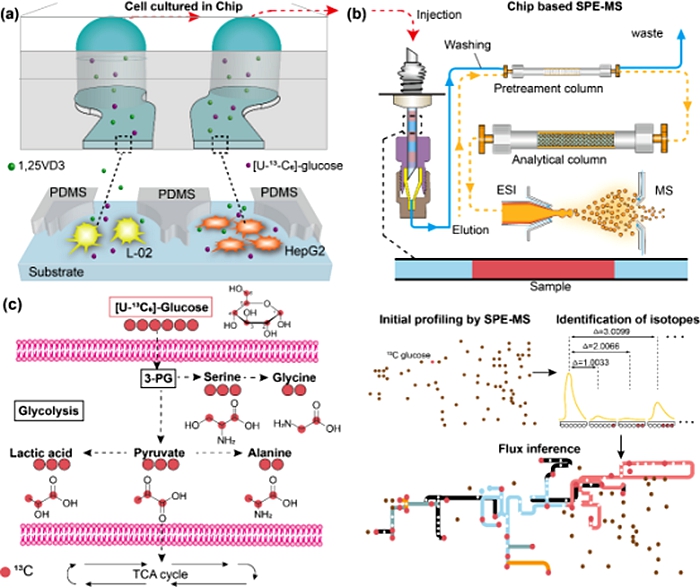Breakthrough in Metabolic Monitoring: Chip-SPE-MS System Unveils Cancer Cell Dynamics in Real Time
Recently, the Institute of Quality Standards and Testing Technology for Agro-Products of the Chinese Academy of Agricultural Sciences developed an isotope tracing-assisted chip-based solid-phase extraction mass spectrometry (Chip-SPE-MS) system for high-sensitivity, high-throughput monitoring of cellular metabolism, with a focus on glucose metabolism and the effects of vitamin D3 metabolites. The corresponding research findings were published in Talanta .
In view of the limitations of traditional metabolic analysis technologies, which struggle to track dynamic metabolic pathways in real time and exhibit insufficient sensitivity in distinguishing isotope-labeled metabolites, researchers innovatively integrated a cell microfluidic chip with online SPE-MS technology to develop a high-resolution, high-sensitivity platform for real-time dynamic cell metabolism analysis. By optimizing cell culture conditions on the microfluidic chip and separation protocols for solid-phase extraction columns, the system achieves automated online enrichment and detection of metabolites such as amino acids and organic acids, with detection limits ranging from 0.10 to 9.43 μmol/mL. Using stable isotope ¹³C₆-glucose tracing technology, this study achieved derivatization-free tracking of dynamic changes in key cancer cell metabolic pathways-including glycolysis and serine synthesis-for the first time. Experimental results revealed that hepatocellular carcinoma cells (HepG2) and colon cancer cells (HCT116) exhibit a pronounced Warburg effect (aerobic glycolysis), with glycolytic activity and lactate production markedly exceeding those of normal liver cells (LO2). The active vitamin D3 metabolite, 1,25-dihydroxyvitamin D3 (1,25VD3), selectively suppressed glucose uptake and downstream metabolite synthesis in HCT116 cells, revealing a VDR-mediated mechanism underlying cancer metabolic reprogramming. The cell chip-SPE-MS system not only advances cancer metabolic heterogeneity research but also shows promise in drug screening, functional compound assessment, and toxicology studies.
This work was supported by the National Key Research and Development Program of China, the National Natural Science Foundation of China and the China Postdoctoral Science Foundation.

Figure 1. The schematic diagram for stable isotope labelling assisted chip-MS system and its applications
The DOI Link of the original paper: https://doi.org/10.1016/j.talanta.2025.127754
By Ning Xu
(xuning@caas.cn)
-
 Apr 11, 2025Strengthening China-Mongolia Grassland Cooperation to Build a Cross-Border Green Ecological Barrier
Apr 11, 2025Strengthening China-Mongolia Grassland Cooperation to Build a Cross-Border Green Ecological Barrier -
 Apr 03, 2025CAAS and CABI Forge a New Chapter in Strategic Cooperation
Apr 03, 2025CAAS and CABI Forge a New Chapter in Strategic Cooperation -
 Mar 21, 2025Experts from IPPCAAS Implement FAO-China South-South Cooperation Project to Advance Sustainable Fall Armyworm Management in Ghana
Mar 21, 2025Experts from IPPCAAS Implement FAO-China South-South Cooperation Project to Advance Sustainable Fall Armyworm Management in Ghana -
 Mar 13, 2025CAAS and CGIAR Deepen Strategic Cooperation
Mar 13, 2025CAAS and CGIAR Deepen Strategic Cooperation -
 Mar 11, 2025Call for Logo Design Proposals for the China-Africa Agricultural Science and Technology Innovation Alliance (CAASTIA)
Mar 11, 2025Call for Logo Design Proposals for the China-Africa Agricultural Science and Technology Innovation Alliance (CAASTIA)
